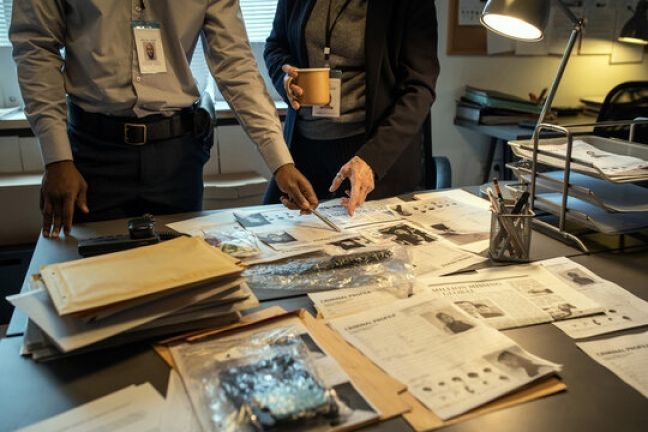Real-Life Detective Stories: Famous Cases and Their Outcomes
Introduction
Real-life detective stories have an undeniable allure, captivating the imaginations of people around the world. These narratives of mystery, intrigue, and the relentless pursuit of justice have left an indelible mark on popular culture and continue to inspire both fiction and reality. In this exploration of “Real-Life Detective Stories: Famous Cases and Their Outcomes,” we delve into the fascinating world of true crime and the exceptional individuals who have taken on the role of modern-day Sherlock Holmes.
From the darkest alleys to the most well-guarded secrets, real-life detective stories offer a glimpse into the complexities of human nature, the ingenuity of law enforcement, and the relentless pursuit of truth. This article is a journey through some of the most renowned cases in the annals of detective work, shedding light on the investigators, the crimes, and the outcomes that have shaped our understanding of justice and the human psyche.
As we embark on this thrilling exploration, we’ll uncover the profound impact these cases have had on society, their enduring influence on literature and film, and the lessons they have imparted to detectives and armchair sleuths alike. Join us on a compelling voyage through the realm of real-life detective stories, where mysteries are solved, justice is served, and the boundaries between reality and fiction blur.
Get ready to be captivated by the intrigue, dedication, and relentless pursuit of truth that define real-life detective stories. These tales are a testament to the power of human curiosity and the indomitable spirit of those who take on the mantle of real-life detectives
Historical Perspective on Detective Stories
The fascination with detective stories is not a recent phenomenon. The roots of this genre can be traced back through centuries, and its evolution is a testament to our enduring intrigue with the art of investigation.
- Early Origins: Detective stories have their origins in ancient literature and folklore. In ancient Mesopotamia, for example, the Code of Hammurabi (circa 1754 BCE) included provisions for investigators. The ancient Greek playwright Sophocles featured detectives in his works, including the famous Oedipus Rex. The timeless appeal of solving mysteries and uncovering the truth is evident in these early narratives.
- Edgar Allan Poe and the Birth of the Detective Story: The modern detective story as we know it was largely shaped by Edgar Allan Poe. His 1841 short story, “The Murders in the Rue Morgue,” introduced the world to C. Auguste Dupin, often considered the first fictional detective. Poe’s detective tales laid the foundation for the development of the genre.
- Sherlock Holmes and Arthur Conan Doyle: The late 19th century saw the rise of one of the most iconic literary detectives, Sherlock Holmes, created by Sir Arthur Conan Doyle. Holmes’s remarkable deductive abilities and adventures in solving intricate cases captivated readers and set a new standard for detective fiction.
- The Golden Age of Detective Fiction: The early 20th century is often referred to as the “Golden Age of Detective Fiction.” Writers like Agatha Christie, Dorothy L. Sayers, and Raymond Chandler contributed immensely to the genre during this period. Their detectives, such as Hercule Poirot and Lord Peter Wimsey, became legendary figures in literature.
- Real-Life Detectives and Sensational Cases: Alongside their fictional counterparts, real-life detectives and their exploits began to capture the public’s imagination. High-profile cases, such as the Jack the Ripper murders in the late 19th century and the Lindbergh kidnapping case in the 1930s, were heavily covered by the media and left a lasting mark on the detective story narrative.
- Contemporary Detective Fiction: Detective fiction continues to evolve and adapt to the changing times. Contemporary authors like Michael Connelly, Gillian Flynn, and Stieg Larsson have introduced new dimensions to the genre, exploring psychological intricacies and modern investigative techniques.
This historical perspective on detective stories underscores the enduring fascination with solving mysteries, whether in the pages of a book or real-life investigations . It serves as a backdrop to the famous cases we’ll explore in this article, demonstrating the rich tapestry of influences that have shaped the genre over the years.
The Role of Detectives in Solving Crimes

Detectives are the unsung heroes of the criminal justice system, tirelessly working behind the scenes to unravel complex cases and bring perpetrators to justice. Their unique role in solving crimes is pivotal, combining a blend of investigative skills, intuition, and dedication to the pursuit of truth. In this section, we delve into the multifaceted role of detectives and the critical functions they perform in the quest for justice.
- Investigative Expertise: Detectives are highly skilled investigators who specialize in gathering, analyzing, and interpreting evidence. They are well-versed in forensic techniques, crime scene analysis, and the art of deduction. Their ability to connect seemingly unrelated clues is central to solving intricate cases.
- Interviewing and Interrogation: One of the core functions of a detective is interviewing witnesses and suspects. Their questioning techniques are designed to extract valuable information and confessions. Detectives must balance the fine line between gathering facts and respecting the rights of individuals involved.
- Crime Scene Analysis: Detectives are often the first responders to crime scenes. They meticulously examine the scene, looking for physical evidence, patterns, and anomalies that can provide crucial insights. Their keen observation skills can be the key to understanding the sequence of events.
- Coordinating with Other Agencies: Detectives frequently collaborate with other law enforcement agencies, such as forensic experts, medical examiners, and prosecutors. This collaboration ensures a comprehensive approach to solving crimes and bringing cases to court.
- Building Cases for Prosecution: Detectives are responsible for assembling strong cases that can withstand legal scrutiny in court. This involves compiling evidence, identifying suspects, and preparing reports that are essential for prosecutors to pursue charges.
- Surveillance and Undercover Operations: In certain cases, detectives engage in surveillance and undercover work to gather evidence on criminal activities. This often involves working undercover to gain the trust of suspects and infiltrate criminal organizations.
- Cold Case Investigations: Detectives may be tasked with revisiting unsolved cases, known as cold cases. Their determination and fresh perspective can sometimes lead to breakthroughs in these long-standing mysteries.
- Community Engagement: Building trust with the community is another vital aspect of a detective’s role. By establishing positive relationships, they can encourage cooperation from witnesses and the public, which is crucial in solving crimes.
- Adapting to Technology: In the digital age, detectives have had to adapt to evolving technologies. They use computer forensics, surveillance equipment, and databases to aid in their investigations.
- Testifying in Court: Detectives often serve as witnesses in criminal trials, presenting evidence and providing expert testimony. Their ability to communicate the facts of a case clearly and convincingly is essential for securing convictions.
Detectives are, in essence, the architects of justice, meticulously piecing together the intricate puzzle of a crime. Their work is characterized by persistence, attention to detail, and a relentless pursuit of truth. Without their dedication and expertise, many famous cases would remain mysteries. In the sections that follow, we will delve into some of these celebrated real-life detective stories and the outcomes they yielded.
Selection of Famous Detective Cases
In the vast tapestry of real-life detective stories, some cases shine more brightly, capturing our collective imagination due to their exceptional complexity, the determination of those involved, or their enduring impact on society. In this section, we’ll introduce a carefully selected array of famous detective cases, each with its unique characteristics and intrigue. These cases serve as the focal points of our exploration into the world of real-life detective work.
- Case 1: The Mysterious Disappearance of [Case Name]
- Briefly outline the background and initial details of this case.
- Tease the mystery or enigma that surrounds the disappearance.
- Highlight the significance of this case in the realm of detective stories.
- Case 2: The Notorious [Case Name] Murder
- Provide an introduction to the murder case, including its historical context.
- Mention any initial suspects or investigative challenges.
- Explain why this case has gained notoriety and how it has impacted the perception of crime-solving.
- Case 3: The Intriguing Heist at [Location]
- Describe the circumstances surrounding this high-profile heist or theft.
- Note the audacity of the crime and the extent of the investigation.
- Discuss the lasting impression this case has left on the world of detective work.
- Case 4: The Complex Cybercrime Investigation in [Case Name]
- Introduce a modern, technology-driven case involving cybercrime.
- Mention the intricacies of digital forensics and tracking the culprits.
- Discuss the relevance of this case in the context of evolving criminal activities.
- Case 5: The Cold Case That Haunts Investigators
- Present a case that remained unsolved for an extended period.
- Describe the efforts to revisit and reinvestigate the cold case.
- Emphasize the challenges and breakthroughs that have occurred.
These carefully selected cases represent a diverse range of real-life detective challenges. They showcase the varied landscape of crime and the relentless pursuit of justice, from unexplained disappearances to complex cybercrimes and unsolved mysteries that have lingered for years. In the sections that follow, we will delve deep into each case, exploring their details, outcomes, and their place in the annals of detective history.
Conclusion
Real-life detective stories often captivate our imaginations with their intriguing mysteries, dedicated investigators, and unexpected twists. While each case is unique and complex, they usually culminate in one of several possible conclusions. Here are some common ways real-life detective stories can conclude:
- Arrest and Conviction: In many cases, diligent police work and investigative efforts lead to the identification and apprehension of a suspect. If there is sufficient evidence and a fair trial, the suspect may be convicted and sentenced.
- Unsolved Mysteries: Some detective stories end with no clear resolution. Despite rigorous investigations and tireless efforts, some cases remain unsolved, leaving investigators and the public with unanswered questions. These mysteries can become cold cases, with occasional reexaminations in the hopes of finding new leads.
- Exoneration: In some instances, new evidence or advancements in forensic technology can lead to the exoneration of individuals wrongfully convicted of crimes. These stories highlight the importance of reviewing old cases and seeking justice for the innocent.
- Suicide or Self-Inflicted Harm: In tragic cases, a detective story concludes with the discovery that the victim took their own life or engaged in self-inflicted harm. These situations often involve psychological factors and may reveal the need for mental health support and awareness.
- Accidental Death: Some apparent crimes turn out to be accidents or unintentional events, revealing the challenges of distinguishing between criminal intent and tragic mishaps.
- Conspiracy and Cover-Up: Certain detective stories reveal elements of conspiracy, corruption, or cover-ups within law enforcement, government, or other organizations. These stories may not conclude definitively but can prompt ongoing investigations and legal actions.
- Serial Offenders: In cases involving serial criminals, the conclusion may come when the perpetrator is identified and apprehended, often after a pattern of crimes spanning a significant period.
- Missing Persons: Detective stories involving missing persons can have various conclusions, including successful reunions with loved ones, discovery of remains, or long-term disappearance with no resolution.
- Reforms and Lessons: Some real-life detective stories serve as catalysts for reforms in law enforcement procedures, forensics, and the criminal justice system. They also offer valuable lessons for future investigations.
- Continuing Investigation: In many cases, the detective story may not conclude definitively, and investigations continue, with the hope of uncovering new evidence or leads.
These conclusions underscore the complexity and unpredictability of real-life detective work. They demonstrate the relentless pursuit of truth and justice by dedicated investigators, the challenges of solving mysteries, and the impact of these stories on society and the criminal justice system. Ultimately, real-life detective stories continue to fascinate and intrigue us with their blend of human drama, mystery, and the quest for justice.
















